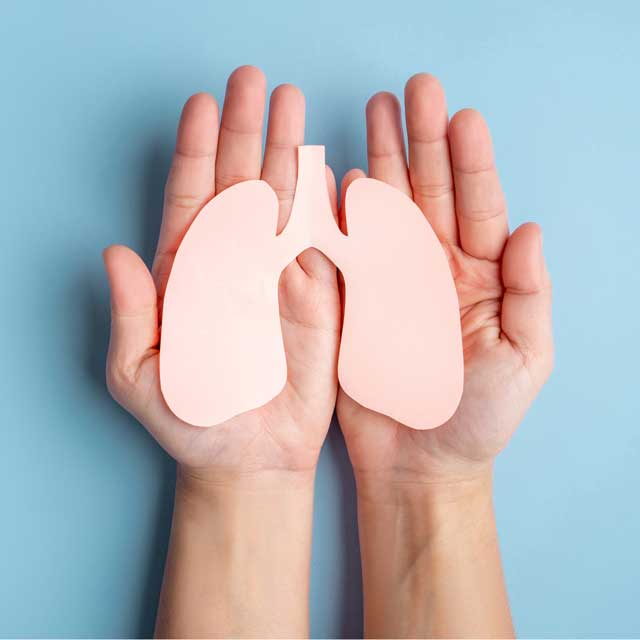All about interstitial lung disease and how to treat it.
For most of us, most of the time, a cough means a bad cold or flu. We might also suspect COVID-19. For Cynthia Kear, though, a nagging cough and a “weird” sensation in her chest turned out to be something else entirely. Kear had interstitial lung disease, also known as ILD. She would need a lung transplant in a few years’ time.
Interstitial lung disease is rare. However, if a patient is diagnosed when the illness is in its early stage, that may give doctors a chance to slow or delay its progression. Here are some things to know about interstitial lung disease and its various treatments, which in severe cases can include lung transplant.
This is not a single disease
Interstitial lung disease actually refers to a group of 200 lung conditions that affect a part of the lung called the interstitium. This network of tissue surrounds and supports the lung’s tiny air sacs.
Interstitial means “lying between things.” This tissue lies between the air sac and the blood vessels. When you breathe in, oxygen crosses this tissue into the bloodstream to be delivered throughout the body. This process happens in reverse to breathe out carbon dioxide.
What these lung conditions have in common is that they cause the interstitium to thicken, with scarring, inflammation or fluid.
There are many causes of ILD vary – and some may be unknown
Many things can contribute to development of interstitial lung disease, including:
- Bacterial, viral or fungal infection, which can cause interstitial pneumonia.
- Breathing in dust or other particles as part of your job can cause disease, including “black lung disease” in coal miners.
- Inflammation can cause it, including autoimmune diseases or sarcoidosis, which can affect many organs but especially lungs and lymph nodes.
- There are also some genetic causes of interstitial lung disease.
Some ILD is considered “idiopathic,” meaning the cause is not known. One of these is idiopathic pulmonary fibrosis, which scars the interstitium.
Symptoms and treatments
Most everyone with one of these conditions will be short of breath. This symptom may get worse over time. The illness may cause a dry cough, and in some cases, people experience weight loss.
For many forms of interstitial lung disease, symptoms develop over time. For some, especially caused by infection, symptoms may come on quickly. A lingering cough, and especially being short of breath, should never be ignored. They should prompt someone to see a doctor.
How the problem is treated depends on how bad it is. Treatments can include medicines, like steroids or anti-fibrotic medications; supportive therapy, such as oxygen or pulmonary rehabilitation; and in severe situations, a lung transplant.
Who is a good candidate for a lung transplant?
Kear was sicker than she realized at first. Her illness was managed with medicines and pulmonary rehabilitation for nearly two years before her lung specialist referred her to his colleagues in the Vanderbilt Lung Institute.
“I was the last to admit I was getting worse, because that would make it real,” she said.
There are medical criteria someone has to meet to be placed on the waiting list for a lung transplant. There are social components, too. At the Vanderbilt Lung Institute, Dr. Ciara Shaver, one of Kear’s Vanderbilt pulmonologists, explained some non-medical factors that made Kear and excellent candidate for lung transplant:
- “I look for someone who is motivated to fight for their health,” Shaver said, and Kear was.
- She had a strong support system. “Whether it’s family or friends, it doesn’t matter, as long as you have an army of people that will work with you to get you through the tough parts of transplant and be able to celebrate the good parts,” Shaver said.
- She was realistic and flexible. “There’s lots of wonderful things about transplant, but there are some bumps in the road,” Shaver said. “When our patients get to a bump, they need to understand that we have a plan and they need to be flexible to work with us, to accomplish the goals necessary to get them through those bumps.”
It is also important, Shaver said, for individuals with interstitial lung disease and their doctors to consider a referral to a highly specialized team of lung disease experts early in the illness.
“When we meet with patients referred for lung transplant, we first make sure we’ve exhausted all other options,” she said, adding that patients can be scheduled at the Vanderbilt Lung Institute within a few weeks at most. “There may be modifiable things we can work with a patient to make transplant more successful.”

Breathe easier
The Vanderbilt Lung Institute brings together experts in diagnosing and treating lung disease from pulmonary medicine, thoracic surgery and allergy. This unique approach gives hope through coordinated, personalized and compassionate care for even the most complex conditions that affect the lungs and breathing.

